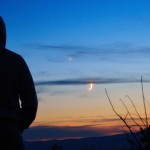

The moon and planets as they appear before sunrise Wednesday, December 2, 2015. Read more.
If you like planets, you still need to get up early. The two most noticeable planets throughout December, 2015, are dazzling Venus (brightest) and Jupiter (second-brightest). Look east before dawn! You can’t miss them. Then look for fainter Mars in between the two. Saturn will join the procession of morning planets, starting around mid-December. Mercury, though nominally an evening planet all month long, won’t be far enough from the setting sun to view till the final week or two of December. And check this out … if you’re in North America, you can witness an awesome planetary event on December 7 as the moon covers, or occults, Venus. Follow the links below to learn more about the December planets.
Mercury, lone evening planet, visible starting around mid-December
Venus, brightest planet in the east before sunrise
Info on December 7 occultation of Venus here
Jupiter, second-brightest planet, high up before sunrise
Mars shines between Venus and Jupiter
Saturn visible before sunrise starting around mid-December
When will all five visible planets appear simultaneously?
Like what EarthSky offers? Sign up for our free daily newsletter today!
Astronomy events, star parties, festivals, workshops

From the Northern Hemisphere, you might be able to use the Summer Triangle to locate Mercury near the horizon in late December. Draw an imaginary line from Vega and through Altair to Mercury. Binoculars could be helpful! Read more
Mercury, lone evening planet, visible starting around mid-December. In early December, 2015, Mercury will be sitting too close to the sunset glare to be visible.
However, we expect people from both Earth’s Northern and Southern Hemispheres to begin to see Mercury in the deepening dusk around the middle of this month. Late month will be best, with Mercury setting 80 to 90 minutes after the sun by the year’s end. Binoculars will help out with your Mercury quest.
Mercury reaches its greatest elongation from the sun December 28 or 29 (depending on your time zone). Mercury will be well placed for viewing for a few weeks, centered on this date. If you live in the Northern Hemisphere, try star-hopping to Mercury from the Summer Triangle, as depicted on the above sky chart for late December.
By the way, Mercury will swing back into the morning sky on January 14, 2016. Later in the January of 2016, Mercury will join up with the other four morning planets – Jupiter, Mars, Venus and Saturn – to feature the first appearance of all five visible planets in the same sky since the year 2005.
Look for all five visible planets in the predawn/dawn sky from about January 20 to February 20, 2016!
When will all five visible planets appear simultaneously?

Circle Monday, December 7, on your calendar to witness the coupling of the moon and Venus before (and after) sunrise. Read more.
Venus, brightest object in the east before sunrise. No matter where you are on Earth, here’s a very fun observation to make this month: Venus before dawn. Venus is the brightest planet and third-brightest sky object overall, after the sun and moon. When it’s visible, it’s very, very prominent in our sky.
So step outside some early morning, and look east. You’ll surely see Venus shining there.
What’s more, use this dazzling world and the planet Jupiter, the fourth brightest celestial object (after the sun, moon and Venus) to locate the fainter planet Mars in the morning sky. Simply look above Venus, but below Jupiter, to see the red planet Mars aligned with Venus and Jupiter in the December morning sky.
And, no matter where you are … be sure to circle Monday, December 7, on your calendar.
The waning crescent moon will have an extremely close encounter with Venus before (and after) sunrise on December 7. Residents of North America will be able to watch the moon occult – cover over – Venus. Depending on where you live in North America, this occultation will be visible in the predawn, dawn or daytime sky on December 7. More info about the occultation here.
You won’t want to miss Venus and the other early morning planets – Jupiter and Mars – which glorify the predawn sky all month long. At mid-northern latitudes, Venus rises about three and one-half hours before the sun at the beginning of the month, and by the month’s end, rises about three hours before sunrise.
At temperate latitudes in the Southern Hemisphere, Venus rises about two and one-half hours before sunup all month long.
Info on December 7 occultation of Venus here

Get up early to see the waning moon, Regulus and Jupiter on the mornings of December 2, 3 and 4. For illustrative purposes, the moon appears larger on this chart than in the real sky. The green line depicts the ecliptic – Earth’s orbital plane projected outward onto the constellations of the Zodiac. Read more.
Jupiter, second-brightest planet, high before sunrise. Jupiter is the first of the morning planets to appear in the sky, rising in the east an hour or so after midnight local time at the beginning of the month. By the month’s end, Jupiter will actually rise before local midnight from both the Northern and Southern Hemispheres.
From all parts of Earth, the king planet Jupiter shines highest in the predawn sky, followed by Mars, Venus and then Saturn (visible near the horizon before sunrise, starting around mid-December).
The waning crescent moon shines close to Jupiter on the mornings of December 3 and December 4.
If you have binoculars or a telescope, it’s fairly easy to see Jupiter’s four major moons, which look like pinpricks of light on or near the same plane. They are often called the Galilean moons to honor Galileo, who discovered these great Jovian moons in 1610. In their order from Jupiter, these moons are Io, Europa, Ganymede and Callisto.
These moons circle Jupiter around the Jovian equator. In cycles of six years, we view Jupiter’s equator edge-on. So, in 2015, we got to view a number of mutual events involving Jupiter’s moons through a high-powered telescope. Click here or here or here for more details.
Click here for a Jupiter’s moons almanac, courtesy of Sky & Telescope.

The waning crescent moon shines close to Mars before sunrise December 5 and 6. Read more.
Mars shines between Venus and Jupiter. Mars is nowhere as bright as Venus or Jupiter. Even so, modestly-bright Mars is easily visible in the predawn sky. Mars shines in between Venus, the sky’s brightest planet, and Jupiter, the sky’s second-brightest, all month long.
Let the waning crescent moon help guide your eye to Mars in the morning sky on December 5 and December 6. If you live in the right place in Africa, you can actually watch the moon occult -cover over – Mars in the predawn sky on December 6. Click here for details.
Mars will continue to brighten month by month, until the Red Planet culminates in brightness in May, 2016. Believe it or not, Mars will be about as brilliant then as Jupiter is now!

In the second half of December, draw an imaginary line from Mars through Venus to locate Saturn near the sunrise point on the horizon. The green line depicts the ecliptic – Earth’s orbital plane projected outward onto the great dome of sky.
Saturn visible before sunrise starting around mid-December. Although Saturn is a morning planet all through December, it’ll be lost in the sun’s glare until about mid-month. Saturn will be fairly easy to locate by the end of the month, as this world rises about two hours before sunrise by the month’s end.
How can you recognize this wonderful planet? By drawing an imaginary line from Mars through Venus to spot Saturn near the sunrise point on the horizon, as shown on the sky chart above for late December. Binoculars may come in handy.
Saturn, the farthest world that you can easily view with the eye alone, appears golden in color. It shines with a steady light. Binoculars don’t reveal Saturn’s gorgeous rings, by the way. For that, you need a small telescope. But binoculars will enhance Saturn’s golden color.
Saturn’s rings are inclined at about 26o from edge-on in December 2015, exhibiting their northern face. A few years from now, in October 2017, the rings will open most widely, displaying a maximum inclination of 27o. As with so much in space (and on Earth), the appearance of Saturn’s rings from Earth is cyclical. In the year 2025, the rings will appear edge-on as seen from Earth. After that, we’ll begin to see the south side of Saturn’s rings, to increase to a maximum inclination of 27o by May, 2032.
Click here for recommended almanacs. They can help you know when the planets in your sky
What do we mean by visible planet? By visible planet, we mean any solar system planet that is easily visible without an optical aid and that has been watched by our ancestors since time immemorial. In their outward order from the sun, the five visible planets are Mercury, Venus, Mars, Jupiter and Saturn. These planets are visible in our sky because their disks reflect sunlight, and these relatively nearby worlds tend to shine with a steadier light than the distant, twinkling stars. They tend to be bright! You can spot them, and come to know them as faithful friends, if you try.
Bottom line: Venus, Mars and Jupiter adorn the predawn/dawn sky all month long. Saturn joins the morning planets around mid-month, whereas Mercury – the lone evening planet – appears at dusk in middle December.
Easily locate stars and constellations with EarthSky’s planisphere.
Don’t miss anything. Subscribe to EarthSky News by email
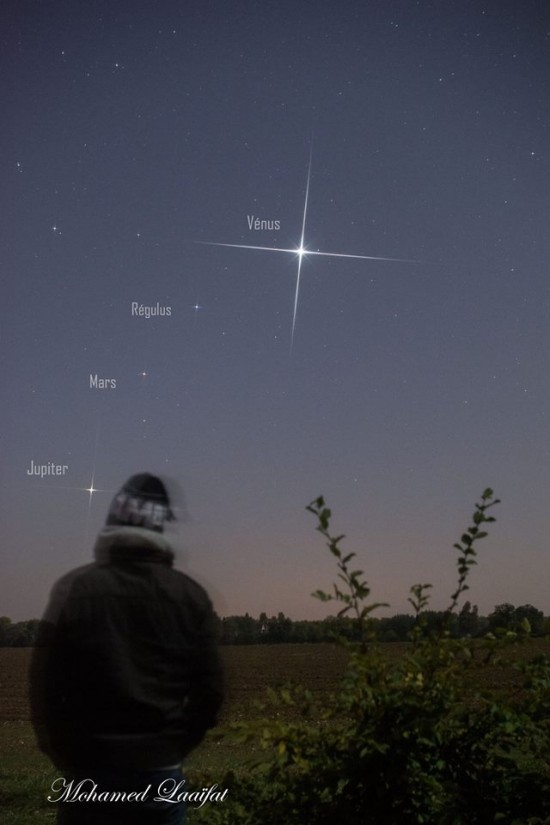
Awesome month for planets before dawn: October, 2015! Photo taken October 2, 2015 by Mohamed Laaifat Photographies in Normandy, France.
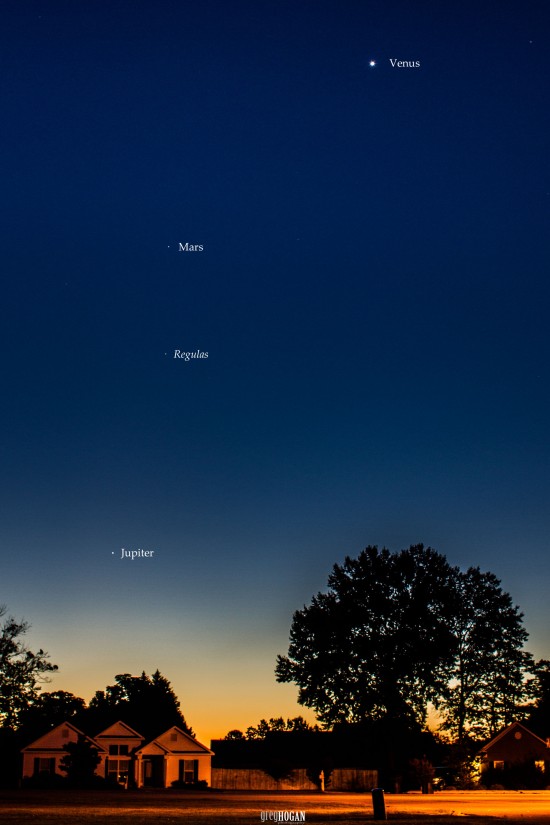
Eastern sky before dawn now. Photo taken September 18, 2015 and submitted to EarthSky by Greg Hogan in Kathleen, Georgia. Thanks, Greg!
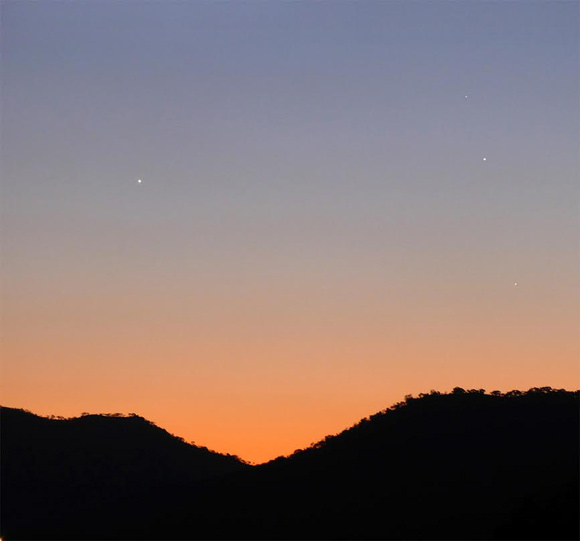
View larger. Evening dusk on August 5: Venus at left. Mercury is climbing higher, toward Regulus (at top) and Jupiter (beneath Regulus).

By the evening of July 12, Venus and Jupiter were farther apart and lower in the western sky after sunset. Photo by Robert Kelly. Thanks, Robert!
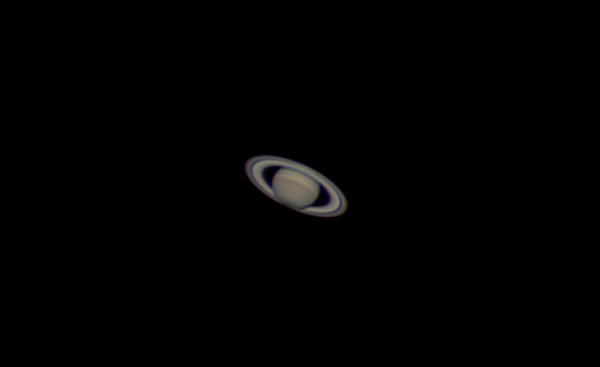
Photo taken June 13, 2015 by John Nelson at Puget Sound, Washington. Thanks, John!
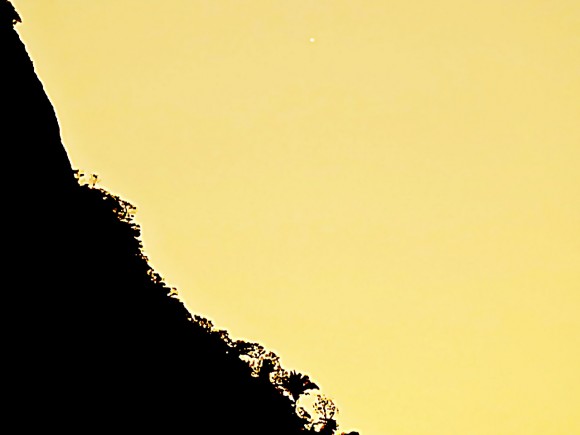
View larger.| Venus near the setting sun on November 18, 2014 by Helio de Carvalho Vital in Rio de Janeiro, Brazil. He wrote, “I managed to capture Venus as it is starting its return to dusk, despite the fact that it is still at a mere 6.2° distance from the sun. The photos show it a few minutes before setting behind the northern side of the 1,021-meter high Tijuca Peak, located some 6.5 km away. It was deeply immersed in the intense glare of the sun, that would set some 13 minutes later.”
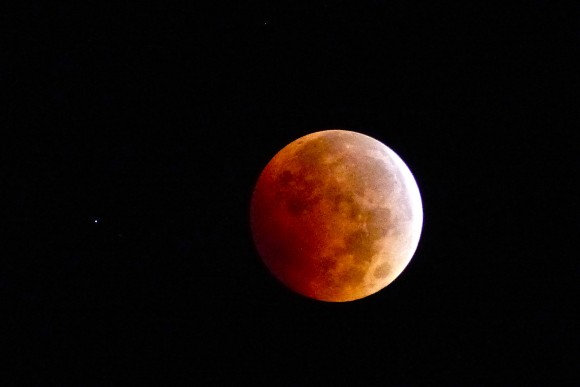
Lunar eclipse on the night of October 8, 2014. The object to the left is the planet Uranus! This beautiful photo is by Janey Wing Kenyon of Story, Wyoming.
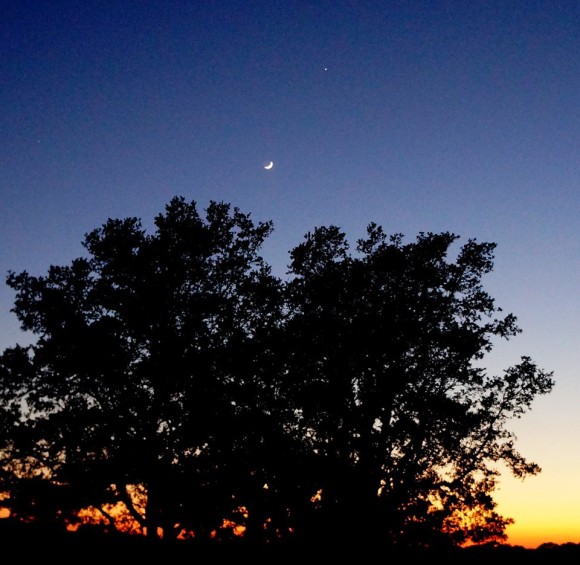
Debra Fryar in Calobreves, Texas captured this photo of the moon and Jupiter on May 31, 2014. Jupiter was close to the twilight then.
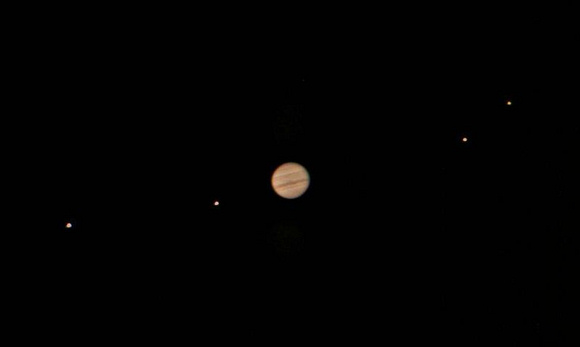
With only a modest backyard telescope, you can easily see Jupiter’s four largest moons. Here they are through a 10″ (25 cm) Meade LX200 telescope. Image credit: Jan Sandberg
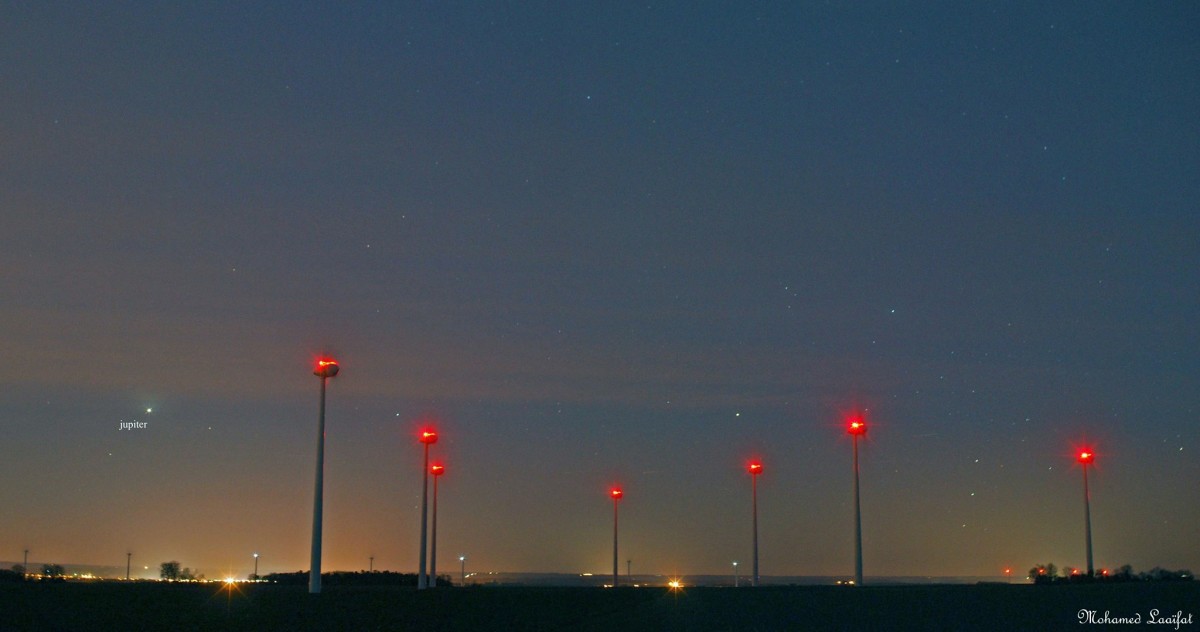
Jupiter was rivaling the streetlights, when Mohamed Laaifat Photographies captured this photo in Normandy, France. Visit his page on Facebook.

Venus by Danny Crocker-Jensen
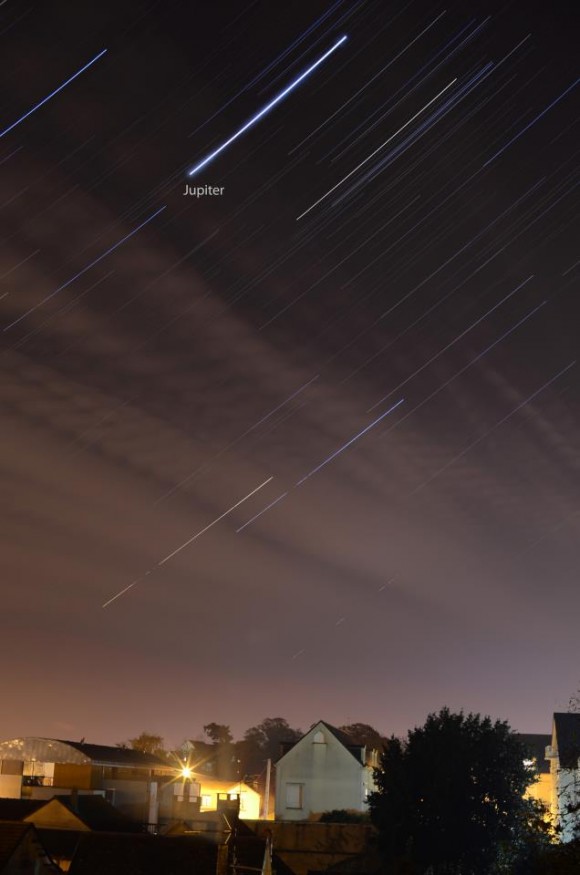
These are called star trails. It’s a long-exposure photo, which shows you how Earth is turning under the stars. The brightest object here is Jupiter, which is the second-brightest planet, after Venus. This awesome photo by EarthSky Facebook friend Mohamed Laaifat in Normandy, France. Thank you, Mohamed.

Skywatcher, by Predrag Agatonovic.
Easily locate stars and constellations with EarthSky’s planisphere.
Don’t miss anything. Subscribe to EarthSky News by email
from EarthSky http://ift.tt/IJfHCr


The moon and planets as they appear before sunrise Wednesday, December 2, 2015. Read more.
If you like planets, you still need to get up early. The two most noticeable planets throughout December, 2015, are dazzling Venus (brightest) and Jupiter (second-brightest). Look east before dawn! You can’t miss them. Then look for fainter Mars in between the two. Saturn will join the procession of morning planets, starting around mid-December. Mercury, though nominally an evening planet all month long, won’t be far enough from the setting sun to view till the final week or two of December. And check this out … if you’re in North America, you can witness an awesome planetary event on December 7 as the moon covers, or occults, Venus. Follow the links below to learn more about the December planets.
Mercury, lone evening planet, visible starting around mid-December
Venus, brightest planet in the east before sunrise
Info on December 7 occultation of Venus here
Jupiter, second-brightest planet, high up before sunrise
Mars shines between Venus and Jupiter
Saturn visible before sunrise starting around mid-December
When will all five visible planets appear simultaneously?
Like what EarthSky offers? Sign up for our free daily newsletter today!
Astronomy events, star parties, festivals, workshops

From the Northern Hemisphere, you might be able to use the Summer Triangle to locate Mercury near the horizon in late December. Draw an imaginary line from Vega and through Altair to Mercury. Binoculars could be helpful! Read more
Mercury, lone evening planet, visible starting around mid-December. In early December, 2015, Mercury will be sitting too close to the sunset glare to be visible.
However, we expect people from both Earth’s Northern and Southern Hemispheres to begin to see Mercury in the deepening dusk around the middle of this month. Late month will be best, with Mercury setting 80 to 90 minutes after the sun by the year’s end. Binoculars will help out with your Mercury quest.
Mercury reaches its greatest elongation from the sun December 28 or 29 (depending on your time zone). Mercury will be well placed for viewing for a few weeks, centered on this date. If you live in the Northern Hemisphere, try star-hopping to Mercury from the Summer Triangle, as depicted on the above sky chart for late December.
By the way, Mercury will swing back into the morning sky on January 14, 2016. Later in the January of 2016, Mercury will join up with the other four morning planets – Jupiter, Mars, Venus and Saturn – to feature the first appearance of all five visible planets in the same sky since the year 2005.
Look for all five visible planets in the predawn/dawn sky from about January 20 to February 20, 2016!
When will all five visible planets appear simultaneously?

Circle Monday, December 7, on your calendar to witness the coupling of the moon and Venus before (and after) sunrise. Read more.
Venus, brightest object in the east before sunrise. No matter where you are on Earth, here’s a very fun observation to make this month: Venus before dawn. Venus is the brightest planet and third-brightest sky object overall, after the sun and moon. When it’s visible, it’s very, very prominent in our sky.
So step outside some early morning, and look east. You’ll surely see Venus shining there.
What’s more, use this dazzling world and the planet Jupiter, the fourth brightest celestial object (after the sun, moon and Venus) to locate the fainter planet Mars in the morning sky. Simply look above Venus, but below Jupiter, to see the red planet Mars aligned with Venus and Jupiter in the December morning sky.
And, no matter where you are … be sure to circle Monday, December 7, on your calendar.
The waning crescent moon will have an extremely close encounter with Venus before (and after) sunrise on December 7. Residents of North America will be able to watch the moon occult – cover over – Venus. Depending on where you live in North America, this occultation will be visible in the predawn, dawn or daytime sky on December 7. More info about the occultation here.
You won’t want to miss Venus and the other early morning planets – Jupiter and Mars – which glorify the predawn sky all month long. At mid-northern latitudes, Venus rises about three and one-half hours before the sun at the beginning of the month, and by the month’s end, rises about three hours before sunrise.
At temperate latitudes in the Southern Hemisphere, Venus rises about two and one-half hours before sunup all month long.
Info on December 7 occultation of Venus here

Get up early to see the waning moon, Regulus and Jupiter on the mornings of December 2, 3 and 4. For illustrative purposes, the moon appears larger on this chart than in the real sky. The green line depicts the ecliptic – Earth’s orbital plane projected outward onto the constellations of the Zodiac. Read more.
Jupiter, second-brightest planet, high before sunrise. Jupiter is the first of the morning planets to appear in the sky, rising in the east an hour or so after midnight local time at the beginning of the month. By the month’s end, Jupiter will actually rise before local midnight from both the Northern and Southern Hemispheres.
From all parts of Earth, the king planet Jupiter shines highest in the predawn sky, followed by Mars, Venus and then Saturn (visible near the horizon before sunrise, starting around mid-December).
The waning crescent moon shines close to Jupiter on the mornings of December 3 and December 4.
If you have binoculars or a telescope, it’s fairly easy to see Jupiter’s four major moons, which look like pinpricks of light on or near the same plane. They are often called the Galilean moons to honor Galileo, who discovered these great Jovian moons in 1610. In their order from Jupiter, these moons are Io, Europa, Ganymede and Callisto.
These moons circle Jupiter around the Jovian equator. In cycles of six years, we view Jupiter’s equator edge-on. So, in 2015, we got to view a number of mutual events involving Jupiter’s moons through a high-powered telescope. Click here or here or here for more details.
Click here for a Jupiter’s moons almanac, courtesy of Sky & Telescope.

The waning crescent moon shines close to Mars before sunrise December 5 and 6. Read more.
Mars shines between Venus and Jupiter. Mars is nowhere as bright as Venus or Jupiter. Even so, modestly-bright Mars is easily visible in the predawn sky. Mars shines in between Venus, the sky’s brightest planet, and Jupiter, the sky’s second-brightest, all month long.
Let the waning crescent moon help guide your eye to Mars in the morning sky on December 5 and December 6. If you live in the right place in Africa, you can actually watch the moon occult -cover over – Mars in the predawn sky on December 6. Click here for details.
Mars will continue to brighten month by month, until the Red Planet culminates in brightness in May, 2016. Believe it or not, Mars will be about as brilliant then as Jupiter is now!

In the second half of December, draw an imaginary line from Mars through Venus to locate Saturn near the sunrise point on the horizon. The green line depicts the ecliptic – Earth’s orbital plane projected outward onto the great dome of sky.
Saturn visible before sunrise starting around mid-December. Although Saturn is a morning planet all through December, it’ll be lost in the sun’s glare until about mid-month. Saturn will be fairly easy to locate by the end of the month, as this world rises about two hours before sunrise by the month’s end.
How can you recognize this wonderful planet? By drawing an imaginary line from Mars through Venus to spot Saturn near the sunrise point on the horizon, as shown on the sky chart above for late December. Binoculars may come in handy.
Saturn, the farthest world that you can easily view with the eye alone, appears golden in color. It shines with a steady light. Binoculars don’t reveal Saturn’s gorgeous rings, by the way. For that, you need a small telescope. But binoculars will enhance Saturn’s golden color.
Saturn’s rings are inclined at about 26o from edge-on in December 2015, exhibiting their northern face. A few years from now, in October 2017, the rings will open most widely, displaying a maximum inclination of 27o. As with so much in space (and on Earth), the appearance of Saturn’s rings from Earth is cyclical. In the year 2025, the rings will appear edge-on as seen from Earth. After that, we’ll begin to see the south side of Saturn’s rings, to increase to a maximum inclination of 27o by May, 2032.
Click here for recommended almanacs. They can help you know when the planets in your sky
What do we mean by visible planet? By visible planet, we mean any solar system planet that is easily visible without an optical aid and that has been watched by our ancestors since time immemorial. In their outward order from the sun, the five visible planets are Mercury, Venus, Mars, Jupiter and Saturn. These planets are visible in our sky because their disks reflect sunlight, and these relatively nearby worlds tend to shine with a steadier light than the distant, twinkling stars. They tend to be bright! You can spot them, and come to know them as faithful friends, if you try.
Bottom line: Venus, Mars and Jupiter adorn the predawn/dawn sky all month long. Saturn joins the morning planets around mid-month, whereas Mercury – the lone evening planet – appears at dusk in middle December.
Easily locate stars and constellations with EarthSky’s planisphere.
Don’t miss anything. Subscribe to EarthSky News by email

Awesome month for planets before dawn: October, 2015! Photo taken October 2, 2015 by Mohamed Laaifat Photographies in Normandy, France.

Eastern sky before dawn now. Photo taken September 18, 2015 and submitted to EarthSky by Greg Hogan in Kathleen, Georgia. Thanks, Greg!

View larger. Evening dusk on August 5: Venus at left. Mercury is climbing higher, toward Regulus (at top) and Jupiter (beneath Regulus).

By the evening of July 12, Venus and Jupiter were farther apart and lower in the western sky after sunset. Photo by Robert Kelly. Thanks, Robert!

Photo taken June 13, 2015 by John Nelson at Puget Sound, Washington. Thanks, John!

View larger.| Venus near the setting sun on November 18, 2014 by Helio de Carvalho Vital in Rio de Janeiro, Brazil. He wrote, “I managed to capture Venus as it is starting its return to dusk, despite the fact that it is still at a mere 6.2° distance from the sun. The photos show it a few minutes before setting behind the northern side of the 1,021-meter high Tijuca Peak, located some 6.5 km away. It was deeply immersed in the intense glare of the sun, that would set some 13 minutes later.”

Lunar eclipse on the night of October 8, 2014. The object to the left is the planet Uranus! This beautiful photo is by Janey Wing Kenyon of Story, Wyoming.

Debra Fryar in Calobreves, Texas captured this photo of the moon and Jupiter on May 31, 2014. Jupiter was close to the twilight then.

With only a modest backyard telescope, you can easily see Jupiter’s four largest moons. Here they are through a 10″ (25 cm) Meade LX200 telescope. Image credit: Jan Sandberg

Jupiter was rivaling the streetlights, when Mohamed Laaifat Photographies captured this photo in Normandy, France. Visit his page on Facebook.

Venus by Danny Crocker-Jensen

These are called star trails. It’s a long-exposure photo, which shows you how Earth is turning under the stars. The brightest object here is Jupiter, which is the second-brightest planet, after Venus. This awesome photo by EarthSky Facebook friend Mohamed Laaifat in Normandy, France. Thank you, Mohamed.

Skywatcher, by Predrag Agatonovic.
Easily locate stars and constellations with EarthSky’s planisphere.
Don’t miss anything. Subscribe to EarthSky News by email
from EarthSky http://ift.tt/IJfHCr
